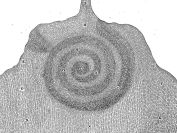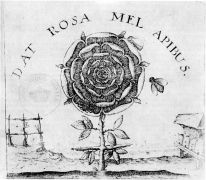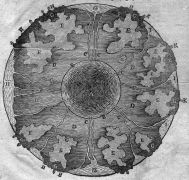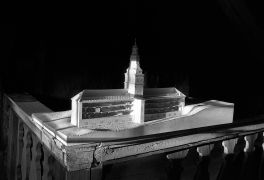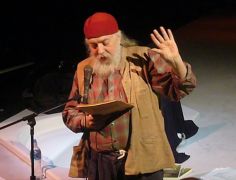Commentary on the tradition of heretics, hermetical sciences, art, nonsense and its meaning in the contemporary arts.
Translated by Jo Williams
The rose has no why; it blossoms because it blossoms.
Angelus Silesius
Depth is hidden. Where? On the surface.
Hugo von Hofmannstahl
For what is hidden … is no interest to us.
Ludwig Wittgenstein
The notion of one, linear history of a single center, most often the West – as the definitive embodiment of civilization and creator of its single history – has been gradual retreat over the last decades of the end of this century; meanwhile, multiple layers of diverse forms of parallel subcultures have slowly been emerging within the public’s consciousness. The revival of the European and world hermetic tradition can also been seen as symptomatic of our search for alternative historical sources, whose existence and importance we are just beginning to recognize.**
The theory has been introduced in various forms over the last several decades that what we have called “postmodern” is a recurring phenomenon and that indeed modernist and postmodernist tendencies have been repeating sequentially throughout history. This is examined in, for example, Art and Discontent: Theory of Millennium (1991) by Thomas McEvilley, a theoretician who has made significant contributions to the relativism of the Euro-American model of art and to the rehabilitation of non-European cultures. The concept of periodically shifting understandings of tradition, memory, and specific layers of tradition is possible to trace back to the model of re-emerging historical cycles explored by Plato in Timaios and The Republic, and by many of his predecessors and successors. From certain angle, this theory also embraces the polarity between the basic, underlying approaches. One is founded in the empirical, material, apparent, visible, and the zeal for the future; the other is rooted in the hidden, marginal, invisible, mythic and mystic, suppressed and esoteric. The majority of hermetic traditions are possible to examine with this fundamental differentiation in mind between orthodox, dogmatic, singular, codified systems-enforced by the powerful and prevailing – and the abstruse, sacred, and secret orders – mainly shared by small and sequestered groups of initiated members. The tension between the ruling, official, sanctioned and the alternative experience of the time-space complex is historically determined and continually transforming; nonetheless, certain patterns and affinities are possible to follow from the ancient eras through to the present. The alchemist of the past were pleased to be called citizens of the cosmos – “cosmopolitans” – and they created suspect groups on the margins of society with their own codex, behavior, secret languages and myths. Even today most withdraw into seduction and search for cryptic forms of communication outside of the mainstream. Their protector and patron remains the ancient god Hermes.
Hermes Revidivus
It is Hermes who bridges the gap between the metalinguistic and the sublinguistic in the form of the message, language itself, the medium; he is the trickster who leads in misleading, the tremendum that echoes through the broken word. Hermes is therefore political, or rather ambassadorial – patron of intelligence and the cryptography as well as an alchemy that seeks only the embodiment of the real. Hermes is between text and image, master of hieroglyphs that are simultaneously both – Hermes is their significance, their translatability. As one who goes “up and down” between spirits and humans, Hermes Psychopomp is the shamanic consciousness, the medium of direct experience, and the interface between these other forms and political. “Hermetic” can also mean “unseen.”
Hakim Bey aka Peter Lamborn Wilson, The Obelisk 2
The cyclical or Orphic model of time and history encompasses two eternal competing forces: sign and image. One experience of time is marked by the inclination towards the concept LOGOS (towards order, clarity, the distinct and visible, and the use of instruments of empiricism and abstraction). Thought and investigation operate here in a linear stream, and were once identified with Universalism and with other forms of fascination with the future. The Miraculous and Mysterious signify here nothing more than an insufficient ability to understand and interpret certain phenomena. The other rhythm in this theatrum mundi moves in relation to Mystery; to search for what is hidden, esoteric, mythic, and beyond the domain of pure reason; to the belief in a past without a beginning, in meanders of time which endlessly repeat, return, and recycle in the chaotic processes of emergence and entropy.
Several proponents of the shift in our paradigmatic comprehension of the world contend that we are now experiencing the passage from reign of scientism and the patriarchal order. Humanity is moving towards a new epoch of creativity, of the synergy among the sciences, philosophy, and art-mythic thought, and of the strengthening of links with tradition.
Throughout human history, the tradition of hermeticism has functioned as a force uniting order and chaos, as an attempt to strike equilibrium humankind and the natural world, linking the macro- and microcosm, the past and present, transforming oppositions into parts of a single chain of elements, beings, essences, and existence. The hermetic tradition has functioned as a force encompassing a variety of cultural expressions, traditions, and myths, like an amalgam of the spiritual and everyday life. The hermetic has always espoused perpetual creation, continuity, and communication.
Mediators are fundamental. Creations is all about mediators. Without them, nothing happens. They can be people – artists or scientists for a philosopher; philosophers or artists for a scientist – but things as well, even plants or animals, as in Carlos Castaneda. Whether they’re real or imaginary, animate or inanimate, one must form one’s mediator. It’s a series: if you don’t belong to a series, even a completely imaginary one, you’re lost. I need my mediators to express myself, and they’d never express themselves without me: one is always working in a group, even when it doesn’t appear to be the case.
Gilles Deleuze, Mediators 5
The term hermeticism is used here freely as the name for that branch of thought which is marked most by a synthetic and synergetic manner towards interpreting of the world. The linguistic root of hermeticism is the Greek word for coming to understand in the sense of an intuitive, active, “meta-meaning” and “meta-understanding” of the “deep” law of the world’s order. Many of the foundations of European thought stem from hermeticism, a tradition historically and philosophically in opposition to authoritative, profane, ideological, and political systems, which have often in the past proved to be authoritative, orthodox, and dogmatic. The ruling classes, which were and are these systems’ bearer and caretaker, have had an unequivocally hostile relationship with any signs of the occult or magic. Secret societies have been persecuted as dangerous, blasphemous, abnormal, and subversive and for centuries have existed and persisted as suppressed cultural forms. For ages the hermetic model of European history of sciences and historiography had been marginalized, had been considered as flawed, uninteresting, and at best as exotic footnote to the “grand story.” By the second half of the twentieth century, scientific and more self-reflexive historical research began to suggest that many of the seemingly singular and clearly-defined traditions of European civilization have been nurtured from roots which lie outside boundaries of the old continent and in the underground regions of our collective thought.
A Change of Position and the Search for Alternatives
The definitive destabilizing critique of the scientific, Cartesian mechanical model of the world, which arose around the end of the 1960s concurrently within the fields of biology, philosophy, astronomy, psychology, physics, cybernetics, and systems theory, has revived interest, at times intense, in the often half-forgotten thinkers of the Middle Ages and the late Renaissance.
Dissatisfaction with one possible and “correct” interpretation of history has led to the rehabilitation of different experiences of time, space, and models of human identity which at times have touched upon the limits of our knowledge. The conception of human life seems today to be far less unambiguous and comprehensible when belief in the guaranteed and absolute development and certainty of human knowledge was widely held. Certain trends within philosophy, sociology, comparative ethnography, ecology, the critical revision of the human, natural, and social sciences, together with developments in technology have allowed for the dismantling of the paradigm of one possible Science and intrinsic Truth. The European has begun to realize the breadth and diversity of all life forms which had for so long been cast aside by the dictates of the single standard. And it is precisely the hermetico-vitalistic tradition that straddles parallel sources from the distant past and functions as a catalyzer helping, in part; to shatter the simplified history and vision of the universe European culture has created for itself.
Hermetic and Heretic
What was in the past (and remains so in many places on this old-new planet) a good excuse for segregation, persecution, and accusations of deviation and heresy, is finally becoming just one of many alternative visions of the world; hermetic and heretic are words with related phonetic roots. It would certainly be interesting, from this vantage point, to interpret European history as the continuous encounter between sacral and occult visions of the world with canonized orders, repressive apparatuses, orthodox syntax, authoritative, binding interpretations of reality, and the endlessly perfected instruments of technology for the mastery of other-let us say contemplative-secret modes of things and ways of living. In his short essay of aphorism “Theses On the Philosophy of History” from 1938, Walter Benjamin poses that unilinear history is a representation of the past constructed by dominant groups and social classes. [1] Heretics, those discontented groups or individuals who did not accept social customs and their ideological basis and by virtue of this engaged in “improper,” “harmful,” “magical” acts and practices, were mercilessly suppressed, if not exterminated. For members of secret societies, hermetism, the kabbalah, gnosis, alchemy, and magic were not only ways to interpret the world, but also a sort of metaphysical defense, an armor, a means of survival in fundamentalist and orthodox social contexts. The history of hermeticism, stretching into the depths of the past, has been handed down and continually renewed as a spiritual instrument for the unveiling of the secret natures of the relationships of all things and beings. Towards these essential connections the adept long and painfully strove, the knowledge then intended only for receptive, attentive, and patient pupils. Hermeticism is thus also a kind of dialect of profane, official languages, formed by its complex systems of symbols and signs, which embody the concept of analogies, harmony, and human communication not only within the hermetics’own closed circles, but also among all of humankind, with animals, god, and the entire cosmos.
Ever since the first Church fathers assumed their spiritual might – from the time of Tertullian and St. Augustine – Alchemy, Astrology, Gnosis, magic, eastern thought, and sexuality have been denounced by the West as heresy. The hermetic model of the primary connection between humanity and the cosmos, which is at its root pluralistic and non-hierarchical, has had no place within (or beside) Catholicism or Protestantism, (even when they and hermeticism have never ceased to influence each other). Pre-Christian and thus non-European thought have for centuries been condemned by Church dogma as merely murky and dark prefaces to the proper enlightened state of humanity that would greet the coming of the true God. Non-European influences upon European education have for the most part been disputed or directly charged with religious deviation. In the Middle Ages hundreds of thousands were executed as pagans and heretics in the name of Truth and the Good. Heretics were burnt and alchemy and hermeticism were lumped together with witchcraft and black magic. Memory not codified in the form of books, images, and objects was annihilated by the iconoclastic guardians of the single, advanced, salutary culture, or later censored and suppressed in the name of progressive “scientific” thought. Islands of relative tolerance such as Spain in the 13th century or Bohemia in the Rudolfian age, where in certain spheres the Christian tradition harmoniously intermixed with Jewish and Islamic culture and hermetic thought penetrated the consciousnesses of the time, were the exception.
The Renaissance of the Hermetic Tradition
The correlations between the postmodern, between the classical model of order and the “barbarian” model of chaos have already been explored in number of art projects and exhibitions and in many publications. In the twentieth-century thinkers such as Mircea Eliade, Rudolf Steiner, Ernst Junger, Needham, van Lennep, C. G. Jung, Gregory Bateson, Ernst Bloch, Paul Tilich, Arthur O. Lovejoy, Arnold Toynbee, Eric Vogelin (and William Blake, Friedrich Nietzsche and Oswald Spengler among those before them), have brought attention to the issues of the dynamic alternating cycles between the antinomies of pragmatic hermeticism and dogmatic rationalism. In the field of biology, a synergetic model of the world was created by Ludwig von Bertalanffy, who called upon the legacy of Gianbattista Vico in the development of the General Systems Theory. The reanimation of seemingly inert matter was popularized by Rupert Sheldrake and Fritjof Capra. The model of Gaia as a planet pulsating with life has much more in common with the hermetic tradition than with positivistic technoscience, even many associating themselves with the ideas of the New Age combine eastern tendencies toward irrationality with western tendencies toward the ethereal and denial of the body.
Since the end of the 19th century, special attention has been concentrated upon the hermetic tradition primarily by those seeking alternatives to the status quo. A number of artists, in opposition to secular bourgeois society, positivistic, and the concept of art as mimetic function sought out sources from alchemy and esoteric disciplines. Among the adepts of esotericism and “practical” hermetics are to be found names such as Piet Mondrian, Kazimir Malevich, Marcel Duchamp, František Kupka, Arthur Schönberg, André Breton, Barnett Newman, Josef Beuys, John Cage, Gary Hill, Bill Viola, Matt Mullican, Matthew Barney, and many others. A look at the twentieth-century influence of hermeticism within Europe (and the United States) can at least suggest the directions taken by contemporary hermetics’ interests and in what in they have been based.
The Baroque and the Twilight of the World of Wonders
Mannerism as the spirit of an age, as the transition between the Renaissance and the Baroque, is considered a turning point in the development of modern society. At that time the conception of the world underwent transformation and the age-old hermetic disciplines and positivism and scientism were rent apart. The period begins around the year 1600 when John Dee bid farewell to England; Giordano Bruno died on the stake and Queen Elizabeth soon thereafter on the throne; René Descartes was to have his visionary dream; Marin Mersenne attempted to divide science from magic; and in their correspondence Newton and Leibniz were to agree upon the (seemingly) definitive boundaries of science. Frances Yates in her books Giordano Bruno and the Hermetic Tradition (1964) and The Occult Philosophy in the Elizabethan Age (1979), traces hermetic motifs in central and western Europe throughout the sixteenth century. The search for ancient spiritual precursors in areas outside of the canonized classical tradition was a pursuit common to many thinkers of the Renaissance. An important impulse came with the rediscovery of the writings of the Corpus Hermeticum from the second of our age. [2]
The study of hermetic and occult inspiration upon the so-called exact sciences provides surprising facts and illumination of obscured parallels between “vitalism” and “scientism.” In The Shapes of Knowledge from the Renaissance to the Enlighment, Allison Coudert presents the example of Francis Mercury van Helmont (1614–1698), whose father, the Belgian Jan Baptista van Helmont, was one of the most significant figures in the early development of modern chemistry. Mercury van Helmont was an impassioned popularizer and translator of Hebrew kabbalistic texts. He was also a close friend of Gottfried Leibniz. From this Coudert deducts the strong influence of the philosophy of the Kabbalah upon Leibniz’s theory of the monad and his work in mathemathics. Frances Yates counts among the thinkers traditionally linked to the humanistic hermetic traditions not only Raymond Lull, Ibn-Khaldun, Mikolas Kusansky, Johannes Kepler, Thomas More, Pico de la Mirandola, Ficino, Robert Fludd, Giordano Bruno, Andreae, Johanes Amos Comenius, Athanasius Kircher, Georg Gottfried Leibniz, Gianbattista Vico, but also Sir Isaac Newton and other founders of The Royal Society of Sciences.
In 1946 John Maynard Keynes astonished in audience in Cambridge with his pronouncement that Newton was not the first modern thinker, but was instead, he maintained: The last of the magicians, the last of the Babylonians and Sumerians, the last great mind who viewed the visible and intellectual world with the same eyes as those who began to build our intellectual inheritance less than 10,000 years ago. […] It is utterly impossible to deny that [Newton’s esoteric investigations are] wholly magical and wholly devoid of scientific value. (J. M. Keynes, Essays in Biography, quoted in Lawrence Weschler, Mr. Wilson’s Cabinet of Wonder).
It seems as though many of the pre-modern thinkers were aware of the Neoplatonist view of the universe and many even drew inspiration from the secret disciplines of ancient Egyptian and Asia. Coudert characterizes this concept as the great chain of being (Arthur O. Lovejoy’s term), a dynamic, holistic world system. One, as Coudert states: … in which planets, men, animals, vegetables, minerals, and metals are linked together in complex hierarchies of correspondences. [This view] encouraged the belief that every existing thing is in some measure a symbol, or reflection, of something else.
After the purification of empirical science of the errors of magic and Church dogma, and after the continually more categorical refusal through the 18th and 19th centuries to intermix science with religion and the occult, the ideas of synergy, analogy, convergence, and the tendency toward the mythic and the unity embracing humanity and the cosmos were all shifted to the realm of sects, romantic art, and the demimonde of the esoteric disciplines.
The Museum and the Wunderkamer
The archetype of the world as a magical whole, a wondrous encyclopedia of all things is reflected in the first collections of art artifacts, natural and rarities, which later formed the inventory of the first museums. Present at the birth of the idea of the Museum was the concept of the Ark, a collection of bizarre, peculiar, fabulous, and rare natural objects technical instruments, and art gathered and housed according to a certain specific system. Ordering these collections involved the numerical, metaphysical, and linguistic of the world. [3]
The tradition of the cabinet of curiosities from the Renaissance to the end of the 18th century, Goethe’s interest in natural oddities being one of the last expressions of the late Baroque pansophistic world. In the era of late capitalism the notion of linking nature’s creations, naturata and naturans together gradually fell out of fashion while knowledge was being segmented into specialized disciplines.
The general acceptance (in Western thought) of the Cartesian system, which assumes the separation of the world into subject and object, led to the rigorous division of science, philosophy, and art into autonomous and mutually exclusive spheres. The turbulent landscape of overlays, intermutuality, and wondrous parallels were assigned to the realm of the freak show, regarded as the marginal, peculiar, and unreliable epistemology of amateur hobbyists of science. The museums also were affected by this shift. What had once been a collection of oddities – a multifarious and wondrous cluster and assemblage of fetishes, naturalia, technical instruments, and art objects from various fields, places, and periods – became a space for the historical over view of isolated artifacts and idols. Here, too, distinct departments and boundaries were created for each field which progressively held less and less in common. The Wunderkamer and Ark of Wonders transformed into buildings for canonized Art, and the Museum gradually lost the mysterious atmosphere of an encyclopedic and experimental warehouse-laboratory of bygone days. Objects of the natural world and technical instruments relinquished their positions for artifacts taken for the most part from religious – votive objects which in the museum context lost their magical and spiritual function. The Art Museum was slowly sublimated into a space where pictures, sculptures, and drawings were displayed like models of furnishings in an otherwise empty, lifeless, and uninhabited home.
Lucretius set out to write the poem of physical matter, but he warns us at the outset that this matter is made up of invisible particles. He is poet of physical concreteness, viewed in its permanent and immutable substance, but the first thing he tells us is that emptiness is just as concrete as solid bodies.
Italo Calvino: Six Memos for the Next Millennium
The recent changes that have been discussed here at length as a shift in paradigm have also penetrated the sacred sphere of Art and have filled it with symptoms of instability and chaos. Installations art, environmental art, performance art, found objects, actions and ideas by the Situationists are examples of another model for the exhibition of art. With them, the Art Museum’s distance from and discontinuity with the outside world are disrupted; it and other spaces are transformed into sites where contemporary art can be in contact with the outside world. Today’s visitor to an art museum is often confronted with work that is not installed within a vitrine or on a pedestal, but which may be touched, even entered. The museum’s interior again contains the props of a theatrum mundi for its visitor to encounter, many of these “sets” and “performances” startling and unsettling in their affect. These art works have the task of penetrating through to our atrophied receptivity to the miraculous. The Dionysian, magical, and mysterious along with hybrids of the physical and pataphysical as well as popular urban and exotic folklore have returned once again to the former fortress of high Apollonian art. Over the last twenty years of Art Museum’s exhibition spaces have been permeated with entirely new forms and expressions of art – employing video, performance, the Internet, film, and other media – that fall outside of the standard, standing interpretation of art. This “chaotic” discontinuity is prominent among the revolutionary forms transforming the Art Museum. What will the Museum be like in the year 2001? Is it within our possibilities to revive the aura of the miraculous which infused the old concept of the Museum as a cabinet of curiosities, as an archetype of Noah’s Ark, as a space where the taxonomy of a collection reflects the wondrous riches of the world?
The peculiar, parascientific of the cabinet of Baroque scientists and scholars, encoded within their search for an arrangement of found objects in fantastic environments, has affinity with the poetic language of the Dadaists, Surrealists, Situtionists, and with many contemporary installation artists. Installation art can in fact be seen as an attempt to revitalize the forgotten relationship between humanity, and its things and words-texts, living spaces, time, and the process of creation. Hermeticism, as an endeavor to grasp the entirety of underlying connections, appears in the context of contemporary art not merely as the inspiration of old encyclopedias with magically realistic illustrations and texts. Oncoming waves of new forms of hermetic thought are rehabilitating the ars combinatorica, methods combining the sensual and virtual, sense and the senseless, the past and future, the invariable and volatile, the ethereal and corporeal. This revised hermeticism searches for, loses, locates unexpected cross-currents within technology, philosophy, mechanics, cybernetics, astronomy, mathematics, the sacred and prosaic, intimate and public, solemn, grotesque, and ridiculous. Meaning, ritual, myth, technique, and banality are interlinked as an amalgam. The esoteric, cloistered hermeticism of the past in being rejuvenated in the more commonplace hermeticism of the vital and creative processes, manifesting itself within the spheres of art, science, and parallel cultures, like a shimmering and inconstant medium for altering visions of the world. The Hermetic Museum of the post-technological epoch will itself be involved with the search for and rediscovery of the wondrous in the “ordinary,” to reinvigorate and nurture the impaired imagination in the upper lofts of our minds and in the senseless activity of the scientists of the pataphysical.
Miloš Vojtěchovský
Translated by Jo Williams
Plasy 1995 / 1996
Notes
According to Benjamin, history records only that which suits those write it and for whom it is written. It discards the Other – whether the Jews, the pagans, or the Gypsies – those who do not belong to “enlightened” and “noble” families, to us the “enlightened” and “civilized,” regarding them if at all as society’s reverse image, and thus as objects of study.
In 1460 this manuscript was found in Constantinople, later transferred to Florence, and painstakingly translated and annotated by Marcilio Ficino. The manuscript is basically a collection of treaties upon Neoplatonic and Gnostic practices. The Humanists of the time mistook them as the work of a single, primordial magus, Hermes Trismegistus, who lived during the time of Abraham, and whom they identified with the Greek god Hermes. After Casaubonus discovery in the seventeenth century of the manuscript’s Hellenistic origins, its aura of ancient wisdom slightly faded, but the role of hermetic science has maintained its importance for the tradition of synergetic thinking and has survived even the hegemony of scientism.
The most celebrated was the collection in Rome held by Athanasius Kircher (which is said to be still stored somewhere under what had been a Jesuit residence); famous as well were the Museum Wormianum in Denmark, and the Rudolfinian collection of curiosities that was looted and dispersed during the Thirty Years’ War.
2. on archived website of Hermit.cz is noted, that "Obelisk" was published in 1997. Which is strange, because this particular text was published in 1996. I think, some version of the Hakim Bey essay was published in 1995. (http://www.t0.or.at/hakimbey/obelisk.htm). Interview of Hans Ulrich Obrist with Peter Lamborn Wilson aka Hakim Bey published in 2017 was accessed 2018 In-Conversation-With-Hakim-Bey
. V češtině vydal překlad kratšího Wilsonova textu in Umělec a nejznámější knihu "Dočasná Autonomní zóna" přeložil Čaroděj a vydal Tranzit v roce 2003. [back]
5.Gilles Deleuze, L'Autre Journal, 8,1985, [back]
